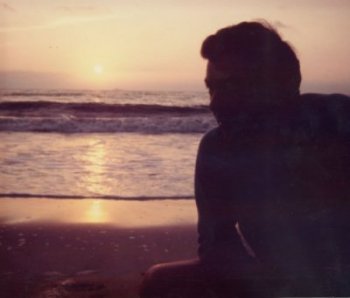
Brendon Joseph Murphy was born in Niagara Falls NY
in 1926. His father lost everything during the depression, so hard work became a way of
life. He joined the US Army Air Force and began active service on Feb 26, 1943 as a Staff
Sergeant. He was in the 445th Bombardment Squadron, 321st Bombardment Group as a Radio
Gunner. He was honorably discharged on November 4, 1945.
When he returned from the war he put himself through
premed school at the University of Buffalo. For practical reasons, he took a job with the
Upjohn Pharmaceutical Company as a Salesman, and left school. He met June Wullen who was a
popular singer at the time, and they married and had 4 girls.
Bren Murphy was a gentleman, a philosopher, and a
mentor to all who knew him. He was the ground all his family and friends stood on. He
expressed to his wife shortly before he died 5 years ago, that he was disappointed that
his girls never asked him about the war. So this is for Brendon Murphy. "We know
now." - Amy Murphy Demeo
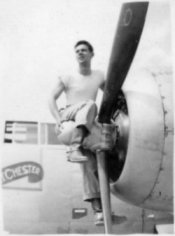
Brendon J. Murphy was trained as a Radio Man which
means he knew how to contact the home base and be able to switch channels using high
frequency signals, not an easy task. The aircraft would maintain radio silence
in order to keep the Germans from tracking their position as they proceeded to the
targets. In addition he was trained as a Gunner and had gone to Gunnery School to
learn how to fire the 50 caliber machine guns B-25's carried. There was one on each
side of the fuselage, the Radio Gunner fired one and the regular gunner fired the other
and in the tail the rear
gunner sitting on a bicycle seat fire two from the rear. There was also an
engineer on board who also served as a mechanic for in flight emergencies and he also was
a Turret Gunner. The turret was in the middle of the fuselage above the wings and he
mounted the turret which had a arc of approximately 150 degrees from side to side and a
deflection device which prevented him from shooting his own tail off. There were two 50's
in the nose, one fixed and the other flexible and fired by the navigator or bombardier
when not on the bomb run. The B-25 was heavily armed and enemy fighters avoided her for
the most part because they could bring ten 50's per airplane to bear upon him, and they
flew very, very close formation which made the fire power even more concentrated.
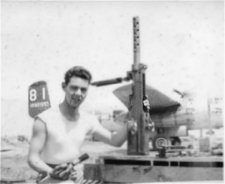
In this picture S/Sgt. Murphy is taking apart and
cleaning his
fifty caliber machine gun. No one did it for him
and he wanted to make
sure it did not jam while firing it. Sort of like
the old west gun fighters.
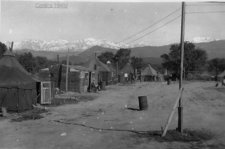
"Corsica"
The 'tent city' or 'squatter village' is a wonderful
depiction of our
tent life, with most people gone there must have been a
mission going on
and crews were gone and ground personnel were out on
the line. Note
that each tent had a chimney that was attached to a pot
belly stove in
the center of the tent. Fuel for the stove was
supplied by 100 octane
aviation fuel through a drip system into the
stove. I believe the tanks
outside held the fuel as we had plenty of water and
showers. Aviation
fuel was used to dry clean our wool olive drab
trousers, jackets, and
shirts. Ingenuity knew no bounds, just look at
the "house". Look at
those beautiful mountains so close to the field.
If you looked out like
the fellow at the 'office' he could see the sea about a
mile away. We
lost a number of crews flying into those
mountains. The picture looks
like February or March. And it did snow
occasionally in the winter and
got bitterly cold.
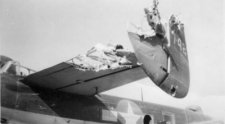
"ORA"
Your Dad would have rather been some place else.
It was one of the most
heavily fortified targets in the Brenner Pass.
The 321st attacked ORA
twice on the 17th of January 1945. You will see
it on a map of Italy
between two other nasty targets Bolzano to the north
and San Michele to the south.
Many times the waist gunners would take
pictures over the targets or
enroute there or back to Corsica.
The "Battle of the Brenner"
pitted determined German and Italian
anti-aircraft gunners against equally determined
American bombers from
the 57th Bomb Wing who were intent on cutting the
supply lines from
Germany to their troops in Italy. "We
won."
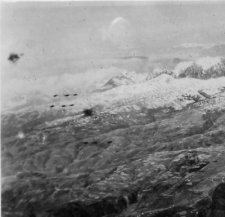
This one over the Alps brings back memories, there
appears to
be a six ship formation down below and ahead and what
appears to be a
couple of flak burst. The picture
then had to have been taken by the
main formation. The ships below would be
anti-flak ships which would
split up and go down into the Brenner and drop
phosphorous bombs on the
German gun positions. They would shut down, Then the
main formation could
then come in with less opposition. I flew twelve
of those in a row
after getting over there and who knows your dad might
have been on one
of those. We became the object of the Germans
intent to destroy and
because we were using phosphorous on the Germans, They
decided it was
chemical warfare and decided we would be shot on sight
if shot down and
kept their promise on several occasions. All crew
members carried a
side arm 45 caliber pistol, "I could have beaten
someone to death with it
but they were safe if I aimed and fired at them."
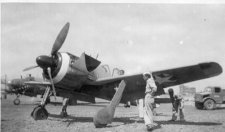
The German airplanes, flew in to Ancona, Italy, Our
base
during March or April, most likely the latter.
They were piloted by
designated pilots who knew the war was going to end
with their
unconditional surrender. As I recall the trainer
definitely came from
Yugoslavia, and perhaps the FW-190 or Me 109 also
because it seems
highly unlikely they could have come through our
fighter cover that way.
Note the steel planking upon which they rest. Our
runways were laid
down on graded land and then spiked into the
ground. They made a lot of
noise but were very effective and could be set up
quickly as we followed
very closely behind the main battle line.
A very special Thank You to Victor J. Hancock, (321st.) Publisher of "The Men of The 57th." for the descriptions of the above pictures.
Mission Record of S/Sgt. Brendon J. Murphy.
March 17, 1945 - Pontevico Rail Bridge, Italy
March 18, 1945 - Palazzola Rail Bridge, Italy
March 19, 1945 - Ora Rail Bridge, Italy
March 25, 1945 - Valargne Gun Positions, Italy
March 30, 1945 - Ala Gun Positions, Italy
March 31, 1945 - Nanerhio Rail Bridge, Italy
April 1, 1945 - Nanerhio Rail Bridge, Italy
April 4, 1945 - Salorno Rail Bridge, Italy
April 9, 1945 - Castel Bolognese Gun Positions, Italy
April 10, 1945 - Longastrino Gun Positions, Italy
April 10, 1945 - Nassa Lombardia Troop Concentration,
Italy
April 11, 1945 - Argent Gun Positions, Italy
April 11, 1945 - San Ambrogio Rail Bridge, Italy
April 12, 1945 - Moribor Rail Bridge, Yugoslavia
April 14, 1945 - Consandolo Troop Concentration, Italy
April 15, 1945 - Matrei Rail Bridge, Austria
April 16, 1945 - Bologna Rail Bridge, Italy
April 17, 1945 - Praduro Rail Bridge, Italy
April 18, 1945 - San Ambrogio Rail Bridge, Italy
April 20, 1945 - San Michele Rail Diversion, Italy
April 22, 1945 - Guarda Veneta Ferry, Italy
April 23, 1945 - Codevigo Rail Bridge, Italy
April 24, 1945 - Vo Sinistro Rail Bridge, Italy
April 25, 1945 - Cavarzere Rail Bridge, Italy
This poem was penned by P/O John Gillespie Magee Jr, in September 1941. P/O Magee was killed during active service with the RCAF on December 11, 1941, he was 19.
Misc. Images
Bad News
Rest Camp at El Rouse
Crew 1945
S/Sgt. Murphy and The Unit
Images of S/Sgt. Brendon J. Murphy's U.S.
A.A.F. Records. (warning large files)
02/16/43 - Report for Duty
09/23/44 - Yuma Gunnery School
Diploma
02/23/45 - Combat Crew Training
Certificate
04/18/45 - The Air Medal
10/15/45 - Bronze Service Star -
Air Combat Balkans
11/09/45 - Enlisted Record and
Report of Separation Honorable Discharge
11/09/45 - Army of the United
States Honorable Discharge
11/09/45 - Army of the United States Separation Qualification
No Date - Army Air Forces,
Certificate of Appreciation - For War Service
Images from the Island of Corsica
The Corsica Club
The Swimming hole
Aircraft Images
P-51 Escort
P-47
P-38 Radar Equipped
Crashed B-24
Crashed B-25
B-25's in flight
A holed B-25
Eruption of Mt. Vesuvius
A note from the Webmaster,
This Web page is devoted to my interest and hobby:
The history of the U.S. Army Air Corps of World War II.
The primary emphasis of my interests is the U.S. 12th.
Army Air Force
and, more generally, the E.A.M.E. Theatre of
Operations. I am
not so much a student of campaigns and strategies,
though, nor do I in any
way embrace the horrors of war. Rather, I see WWII as a
defining part of
history and, ultimately, the war was experienced by
real people both home
and abroad and who had thoughts and feelings which
reflect the events of
the time. Seeking out personal accounts of those who
fought and survived
or gave their lives provides me with a greater
appreciation for the true
nature of the period. I hope you find these pages
interesting and helpful. --- J.F.K.